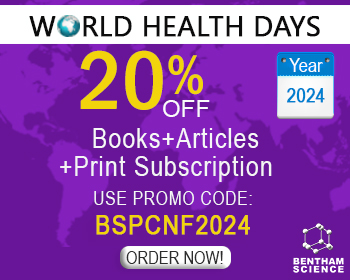摘要
背景:利什曼病是一种被忽视的热带病,与多种临床表现有关,包括皮肤,粘膜皮肤和内脏形式。由于当前可用的药物具有某些局限性(毒性,耐药性等),因此基于靶点的鉴定已成为开发抗利什曼病新线索的重要方法。本研究旨在确定与强效抗疟药化合物的药理作用有关的靶标。 方法:讨论了过去近十年来研究的抗菊苣化合物分子相互作用的文献资料。该信息是从诸如Wiley,SciFinder,Science Direct,国家医学图书馆,美国化学学会,在线科学电子图书馆,Scopus,Springer,Google Scholar,Web of Science等数据库中获得的。 结果:许多体外抗菌动物化合物与精氨酸酶,蝶啶还原酶1,锥虫硫醚还原酶,丙酮酸激酶等酶表现出亲和力和选择性相互作用,这对于利什曼原虫的存活和致病性至关重要。 结论:小分子(酶,蛋白质等)的计算机模拟活性可以用作开发治疗利什曼病的候选化合物的药理学工具。由于某些药理活性化合物可能作用于一个以上的靶标,因此对强效抗菌药物作用机理的进一步研究可能有助于更好地理解其药理作用。同样,最有前途的抗疟疾化合物的优化可能会改善其生物学活性。
关键词: 利什曼病,生物信息学,计算机软件,药理学,药物靶标,分子建模。
[http://dx.doi.org/10.4103/0974-777X.62883] [PMID: 20606971]
[http://dx.doi.org/10.1016/S1995-7645(12)60084-4] [PMID: 22575984]
[http://dx.doi.org/10.1016/B978-0-12-407679-2.00005-3] [PMID: 23415155]
[http://dx.doi.org/10.1016/bs.armc.2018.08.002]
[http://dx.doi.org/10.1007/978-1-4939-6634-9_5] [PMID: 27873247]
[http://dx.doi.org/10.1186/s12859-018-2109-2] [PMID: 29523085]
[http://dx.doi.org/10.1098/rsif.2012.0835] [PMID: 23235262]
[http://dx.doi.org/10.1128/AAC.04742-14] [PMID: 25583728]
[http://dx.doi.org/10.1016/j.bioorg.2017.02.005] [PMID: 28228228]
[http://dx.doi.org/10.1002/ardp.201500312] [PMID: 26627058]
[http://dx.doi.org/10.1016/j.jmgm.2018.11.014] [PMID: 30522092]
[http://dx.doi.org/10.1017/S003118201600216X] [PMID: 27974063]
[http://dx.doi.org/10.1517/14656566.2015.973850] [PMID: 25346016]
[http://dx.doi.org/10.2174/1573406414666180115094630] [PMID: 29332596]
[http://dx.doi.org/10.1016/j.clindermatol.2006.05.008] [PMID: 17350500]
[http://dx.doi.org/10.1590/abd1806-4841.20142226] [PMID: 24626648]
[http://dx.doi.org/10.1007/s40257-015-0114-z] [PMID: 25687688]
[http://dx.doi.org/10.4269/ajtmh.16-84256] [PMID: 27927991]
[http://dx.doi.org/10.1371/journal.pone.0035671] [PMID: 22693548]
[http://dx.doi.org/10.1016/j.ijwd.2019.01.002] [PMID: 31360749]
[http://dx.doi.org/10.1111/j.1365-2230.2004.01605.x] [PMID: 15347324]
[http://dx.doi.org/10.1371/journal.pntd.0000259] [PMID: 18958168]
[PMID: 23906253]
[http://dx.doi.org/10.1016/S1808-8694(15)31181-2] [PMID: 18278231]
[http://dx.doi.org/10.2223/1154] [PMID: 15079185]
[http://dx.doi.org/10.1111/j.1365-2915.2012.01034.x] [PMID: 22924419]
[http://dx.doi.org/10.1146/annurev-ento-120811-153557] [PMID: 23317043]
[http://dx.doi.org/10.1007/978-1-4614-8869-9]
[http://dx.doi.org/10.1111/ijd.14002] [PMID: 29663351]
[http://dx.doi.org/10.1007/s40291-018-0343-y] [PMID: 29922885]
[http://dx.doi.org/10.1371/journal.pntd.0003208] [PMID: 25275483]
[http://dx.doi.org/10.2174/1573406412666160909152614] [PMID: 27629824]
[http://dx.doi.org/10.4103/0974-777X.62866] [PMID: 20606968]
[http://dx.doi.org/10.1136/bmj.326.7385.377] [PMID: 12586674]
[http://dx.doi.org/10.1007/s12539-014-0188-y] [PMID: 24464704]
[http://dx.doi.org/10.1016/j.actatropica.2018.02.010] [PMID: 29452111]
[http://dx.doi.org/10.1080/17460441.2017.1308351] [PMID: 28306350]
[http://dx.doi.org/10.1016/j.cell.2015.07.016] [PMID: 26232224]
[http://dx.doi.org/10.3892/ijmm.2019.4188] [PMID: 31115493]
[http://dx.doi.org/10.1039/C2DT31833D] [PMID: 23018626]
[http://dx.doi.org/10.1371/journal.pone.0025273] [PMID: 21966477]
[http://dx.doi.org/10.2478/s11686-014-0203-9] [PMID: 24570045]
[http://dx.doi.org/10.1155/2014/614014] [PMID: 24800243]
[http://dx.doi.org/10.1042/BJ20081386] [PMID: 19061483]
[http://dx.doi.org/10.1016/S0166-6851(97)02828-4] [PMID: 9108556]
[http://dx.doi.org/10.1111/j.1365-2958.2010.07214.x] [PMID: 20497506]
[http://dx.doi.org/10.1016/j.biopha.2018.07.056] [PMID: 30119174]
[http://dx.doi.org/10.3390/molecules23123160] [PMID: 30513673]
[http://dx.doi.org/10.1016/j.parint.2016.01.001] [PMID: 26772973]
[http://dx.doi.org/10.3390/molecules23040772] [PMID: 29584709]
[http://dx.doi.org/10.1016/j.ijbiomac.2018.10.053] [PMID: 30321635]
[http://dx.doi.org/10.1016/j.molbiopara.2009.01.001] [PMID: 19393161]
[http://dx.doi.org/10.1016/j.exppara.2012.01.015] [PMID: 22327179]
[http://dx.doi.org/10.1128/AAC.00499-12] [PMID: 22850521]
[http://dx.doi.org/10.1016/j.exppara.2017.11.009] [PMID: 29191699]
[http://dx.doi.org/10.1126/science.3883489] [PMID: 3883489]
[http://dx.doi.org/10.1371/journal.pone.0056788] [PMID: 23451087]
[http://dx.doi.org/10.4155/fmc-2016-0180] [PMID: 27957878]
[http://dx.doi.org/10.1371/journal.pntd.0006969] [PMID: 30475811]
[http://dx.doi.org/10.1016/j.ejmech.2016.08.048] [PMID: 27597410]
[http://dx.doi.org/10.1073/pnas.0704384105] [PMID: 18245389]
[http://dx.doi.org/10.1021/jm300563f] [PMID: 22946585]
[http://dx.doi.org/10.1016/j.jmb.2005.06.076] [PMID: 16055151]
[http://dx.doi.org/10.1016/j.ejmech.2016.12.019] [PMID: 28012342]
[http://dx.doi.org/10.1016/j.ejmech.2016.03.022] [PMID: 27017551]
[http://dx.doi.org/10.1016/j.ejmech.2015.02.038] [PMID: 25768697]
[http://dx.doi.org/10.1016/j.jgar.2019.02.008] [PMID: 30797085]
[http://dx.doi.org/10.1016/j.bmcl.2017.12.013] [PMID: 29258770]
[http://dx.doi.org/10.1016/j.bmcl.2017.06.053] [PMID: 28693910]
[http://dx.doi.org/10.1016/j.bmcl.2015.12.085] [PMID: 26778149]
[http://dx.doi.org/10.3109/10799893.2016.1171344] [PMID: 27147242]
[http://dx.doi.org/10.1016/j.biopha.2016.06.010] [PMID: 27470561]
[http://dx.doi.org/10.1080/07391102.2018.1502096] [PMID: 30058445]
[http://dx.doi.org/10.1016/j.ejmech.2018.04.057] [PMID: 29758517]
[http://dx.doi.org/10.1016/j.bcp.2016.12.012] [PMID: 28017772]
[http://dx.doi.org/10.1080/07391102.2015.1135298] [PMID: 27043972]
[http://dx.doi.org/10.2174/1386207319666160907102235] [PMID: 27604957]
[http://dx.doi.org/10.3389/fphar.2016.00107] [PMID: 27199750]
[http://dx.doi.org/10.1111/cbdd.13326] [PMID: 29729080]
[http://dx.doi.org/10.1017/S0031182016002237] [PMID: 28031079]
[http://dx.doi.org/10.1016/j.bmcl.2017.04.010] [PMID: 28434763]
[http://dx.doi.org/10.1128/AAC.00352-16] [PMID: 27503653]
[http://dx.doi.org/10.1016/j.ejmech.2018.10.065] [PMID: 30408746]
[http://dx.doi.org/10.1021/cr5003134] [PMID: 25337991]
[http://dx.doi.org/10.1155/2009/642502] [PMID: 19680554]
[http://dx.doi.org/10.1371/journal.pntd.0003588] [PMID: 25768284]
[http://dx.doi.org/10.1016/j.molbiopara.2003.10.002] [PMID: 14698427]
[http://dx.doi.org/10.1016/j.parint.2018.12.006] [PMID: 30582997]
[http://dx.doi.org/10.1002/ardp.201500392] [PMID: 27214743]
[http://dx.doi.org/10.1248/cpb.c17-00293] [PMID: 28966275]
[http://dx.doi.org/10.1186/s40199-017-0174-0] [PMID: 28376844]
[http://dx.doi.org/10.1038/s41598-017-00848-8] [PMID: 28389670]
[http://dx.doi.org/10.1007/s11030-015-9652-9] [PMID: 26754628]
[http://dx.doi.org/10.1002/jcb.26433] [PMID: 29058760]
[http://dx.doi.org/10.1016/j.bmcl.2016.12.018] [PMID: 28003139]
[http://dx.doi.org/10.1038/s41586-018-0356-z] [PMID: 30046105]
[http://dx.doi.org/10.1038/nrd.2016.244] [PMID: 28104905]
[http://dx.doi.org/10.1111/cbdd.13176] [PMID: 29415325]



























